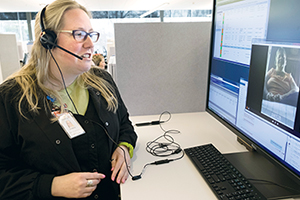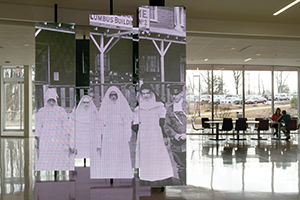Telehealth services augment care, improve outcomes in and out of the hospital
By BETSY TAYLOR
CHESTERFIELD, Mo. — From her home in rural Washburn, Mo., Norma Stryffeler answers a video call on her iPad to visit with her Mercy Virtual navigator Christina Meckfessel, who is located more than 280 miles away in suburban St. Louis.

Mercy Virtual Care Center patient navigator Christina Meckfessel is part of a team that regularly assesses the health status of patient Norma Stryffeler through video check-ins and streamed biometric data. Stryffeler says she has been able to better manage her chronic lung condition with support from the Mercy telehealth program, vEngagement. Photo by Sid Hastings/© CHA
"Hi, Norma," Meckfessel says. "How you doing today? All your vitals and everything are looking good today." The 56-year-old Stryffeler is a patient of the Mercy Virtual Care Center, the e-medicine branch of the Mercy health care system, which Mercy says is the nation's largest hub for virtual care services.
Stryffeler has chronic obstructive pulmonary disease, and a few months ago, Mercy Virtual helped her get Internet at home and supplied her with a monitoring kit that included an electronic tablet, a wireless scale that records and transmits her weight and an electronic blood pressure monitor with pulse oximeter. Stryffeler has a Mercy Virtual care team made up of Meckfessel, a nurse and a nurse practitioner who coordinate her care.
Mercy, a nonprofit health care system with operations in Missouri, Kansas, Arkansas and Oklahoma, has invested about $300 million in virtual health care over more than a decade, says Dr. Randall Moore, president of Mercy Virtual when this story was reported. Moore left the organization in late March.
That investment includes about $50 million in initial building and technology costs for its virtual care hub, where Stryffeler's care team and hundreds of other virtual care employees work. Mercy has 11 virtual care services (see below), including vEngagement. That's the program Stryffeler is enrolled in.
Chronic disease management
vEngagement supports chronically ill patients in collaboration with each patient's primary care provider and specialists. The vEngagement program currently has about 1,000 patients.
"Yeah, I'm a pioneer," Stryffeler says.
In the vEngagement program, the virtual navigator initiates each video call, building relationships with patients, scheduling health appointments, and answering any questions about using in-home, Bluetooth-enabled technology to transmit vital signs. That data is reviewed daily by Mercy Virtual clinicians. vEngagement patients participate in virtual visits at least weekly, and sometimes daily.

Video screens prominently placed in the lobby of Mercy Virtual Care Center in Chesterfield, Mo., tie the legacy and health care charism of the Sisters of Mercy to telehealth services based at Mercy's virtual care hub. Photo by Sid Hastings/© CHA
The navigator performs what is known as a warm hand off to a nurse for a visual check-in and review of the patient's health. If there's an immediate need or deterioration in the patient's condition, the call is transferred to the team's nurse practitioner. Once every three months, the nurse practitioner rather than the nurse performs the virtual exam.
The criteria to become a vEngagement patient includes factors such as the patient's diagnosis and frequency of hospitalizations. An enrollment team reviews medical charts to identify prospective patients who might benefit from program participation. Mercy physicians also can refer a patient to the program. In either case, patients must opt in to the vEngagement program.
Stryffeler says when Mercy called her to offer vEngagement services, "I was sick enough to go into the hospital. I needed this really bad."
Through the services she says she has gained a better understanding of her health care readings; and, with the virtual care team able to assess and intervene early when she's not feeling well, she's been able to reduce hospitalizations.
With encouragement from her care providers at Mercy Virtual, Stryffeler quit smoking in January. And Stryffeler finds the frequent check-ins reassuring. "It has made it to where I don't have to stress over how I'm doing," she says.
A vEngagement patient trying to change a bad habit may get frequent electronic messages of encouragement from members of their care team. If a patient wants more education about their condition, a navigator can send them a video to view on the tablet device.
Pets and Coke cans
Meckfessel, Stryffeler's navigator, works on a vEngagement care team that includes Christina Ward, a registered nurse, and Coleen Rakers, a nurse practitioner. From side-by-side workstations they coordinate the care of patients, working with Mercy Virtual physicians as well as with each patient's community-based primary care physician and specialists.

Registered Nurse Christina Ward cares for Mercy Virtual Care Center patients through virtual visits.
Photo by Sid Hastings/© CHA
There are three vEngagement teams at Mercy Virtual headquarters; each team is made up of one physician, three advanced practitioners, nine nurses and nine navigators. Providers say they all work to the top of their respective scopes of practice.
Many people have asked Ward if she misses bedside nursing. "I feel this is really more intimate," she says. Through a video connection, she meets patients in their homes where they feel at ease in their environments. She gets to know family members and even pets. Should a diabetic sip a can of Coke during the visit, Ward will use it as a teaching moment, suggesting a healthier, sugar-free beverage.
The navigator may encourage a patient to begin building endurance with a daily walk to the mailbox and then progress to short walks with the dog, building up distance over time.
Command center
Two floors of the Mercy Virtual Care Center have open floor plans, where rows of care providers sit at desks, monitoring patients in several states, checking in via two-way video with patients and their local care providers, analyzing individuals' health care data and contacting patients' local health care providers with updates when it's warranted.
Privacy screens are located behind each workstation, so a patient's video call is shielded from the view of others. Employees are focused; white noise is piped in and the conversation is muted. The center is staffed around the clock, with individual programs staffed based on need.
Fabric of care
To determine what virtual care services to provide, Moore says Mercy analyzes the entire continuum of care, prioritizing where Mercy Virtual can make the biggest difference to improve patients' clinical outcomes, increase the system's operational capacity, lower costs and make the experience of care more positive for patients and their care teams.
"To the degree that we can make virtual care disappear into the fabric of care, we will be successful," he says, adding that virtual care fills gaps in the continuum of care and identifies patients' needs earlier than they would have been identified in the past. Using virtual care providers can "respond more proactively and respond more completely because we can leverage teams and resources," he says.
"If you're getting sick at home at two in the afternoon, we can see you (then and) again at six in the evening. We can see you again at midnight to make sure you're getting what you need."

Dr. Gavin Helton, Mercy Virtual's copresident, says the center's around-the-clock care creates a safety net for patients and allows rapid response to their needs.
Photo by Sid Hastings/© CHA
Patient-centered care
Dr. Gavin Helton, copresident of Mercy Virtual, said many patients receiving episodic care in health care settings benefit from regular medical support aimed at helping them manage chronic conditions.
And the service offers convenience for patients with mobility or transportation barriers. A member of the vEngagement team can schedule a patient to receive radiology tests or intravenous treatments at home. A chaplain can make a virtual video visit to pray with a patient. "It's whatever is best for the patient," Helton says.
Moore says by focusing on improving patients' health, intervening sooner when patients need care, filling gaps in care and augmenting the work of care providers who provide face-to-face physical care to patients, the work of Mercy Virtual reduces health care costs. The national shift toward value-based payments in health care increasingly allows the system to be rewarded for reducing costs.
In addition to being an aid to patients in their homes, Moore says virtual care is going to become increasingly more integrated into the care at outpatient and inpatient facilities, improving outcomes and reducing costs.
He says Mercy Virtual's intensive care patients have stays in the ICU and hospital that are an average of 35 percent shorter than would be expected using an ICU risk adjustment calculator. This equates to about 140,000 fewer bed days annually for Mercy Virtual's patients. Mortality is also running about 35 percent below what ICU risk analysis tools suggest it would be without the virtual monitoring and care. "That's somewhere between 1,300 and 1,500 people (annually) who are going home who were predicted to die," he says.
|
Mercy expands virtual care servicece
Mercy has been building its capabilities in virtual medicine for more than a decade, a strategy intended to improve access to care and improve outcomes. Mercy Virtual Care Center came online in 2015 as a telehealth hub with the capacity to accelerate Mercy's expansion into more virtual medicine service lines.
vConsult — Plans call for this new program to provide specialty consults including neurology, oncology and pediatrics to Mercy's 19 critical access hospitals. Neurology is the first consultative service being piloted.
vEmergency — A program that is currently being piloted, with plans to expand to all of Mercy's critical access hospitals — facilities that do not have an emergency department physician on staff or on call around the clock.
vStroke — Mercy Virtual neurologists collaborate with emergency physicians in hospitals to diagnose strokes and oversee the administration of clot-busting medications.
vHospitalist — Mercy Virtual staff support the patient's bedside team through real-time assessment, documentation, orders for tests and therapies, and efficient management of admissions and transfers.
vICU — Mercy says it operates the largest single-hub electronic ICU in the country. Staff provide around-the-clock care that augments critical care teams. Mercy Virtual provides this service to other health care systems in addition to Mercy ICUs.
vSepsis — This program uses algorithms, test results, vital signs and centralized monitoring by critical care clinicians to detect sepsis in its earliest stages in hospitalized patients. Detection often occurs — and treatment ensues — before patients exhibit symptoms of the life-threatening condition.
vSitter — This program employs two-way audiovisual technology to provide continuous observation of designated ICU patients deemed to be at-risk. Its staff are located at Mercy Hospital St. Louis.
vAlert — Staff monitor data from patients' monitors and alert unit staff when a hospital patient's condition is deteriorating.
vKids — Pediatricians and pediatric nurses provide virtual care to young outpatients with chronic conditions through this new service. They coordinate care with children's local doctors.
vEngagement — This program supports chronically ill patients in their homes in collaboration with each patient's primary care provider and specialists.
vMentalWellness — Mercy is beginning the process of integrating vMentalWellness into every service line offered through Mercy Virtual. vMental Wellness was first offered to vEngagement patients. Those who screen positive for depression, anxiety or other mental health concerns can receive virtual vMentalWellness visits.
— BETSY TAYLOR
|
Copyright © 2018 by the Catholic Health Association
of the United States
For reprint permission, contact Betty Crosby or call (314) 253-3490.